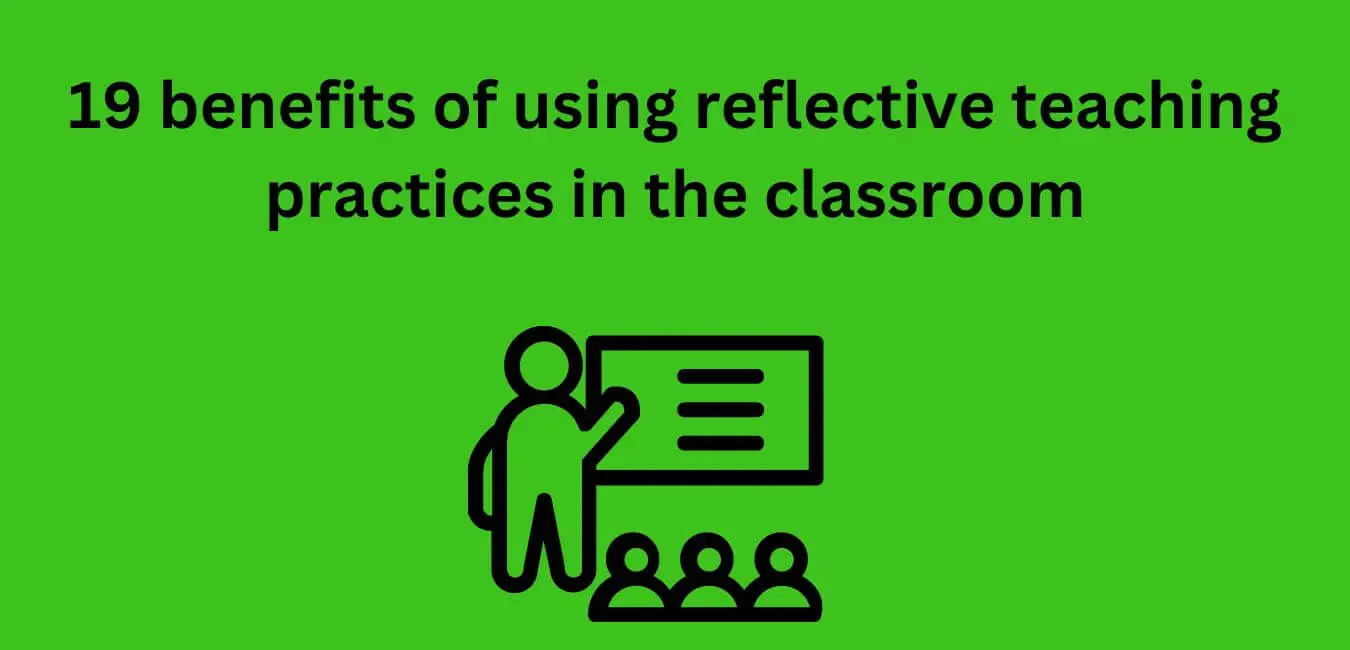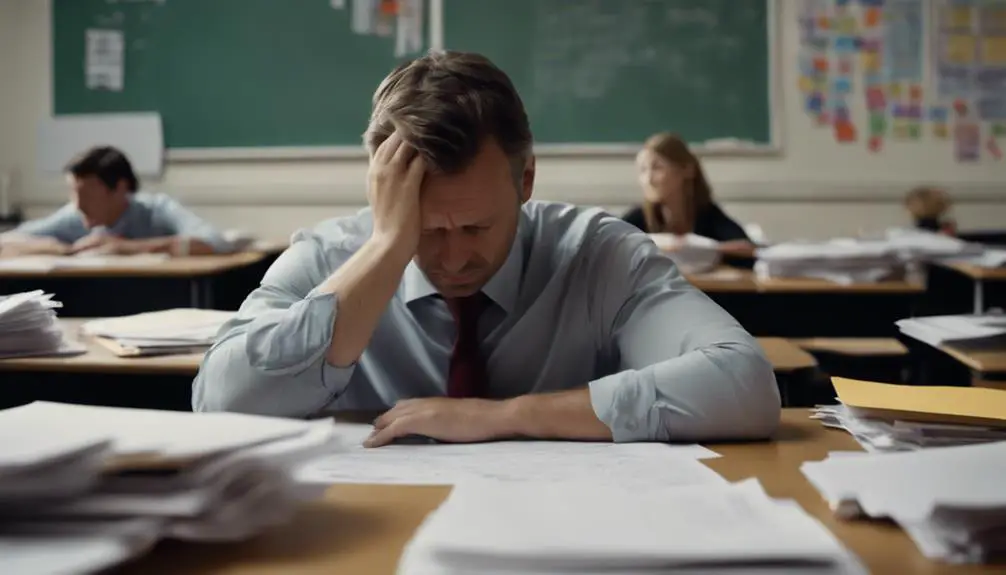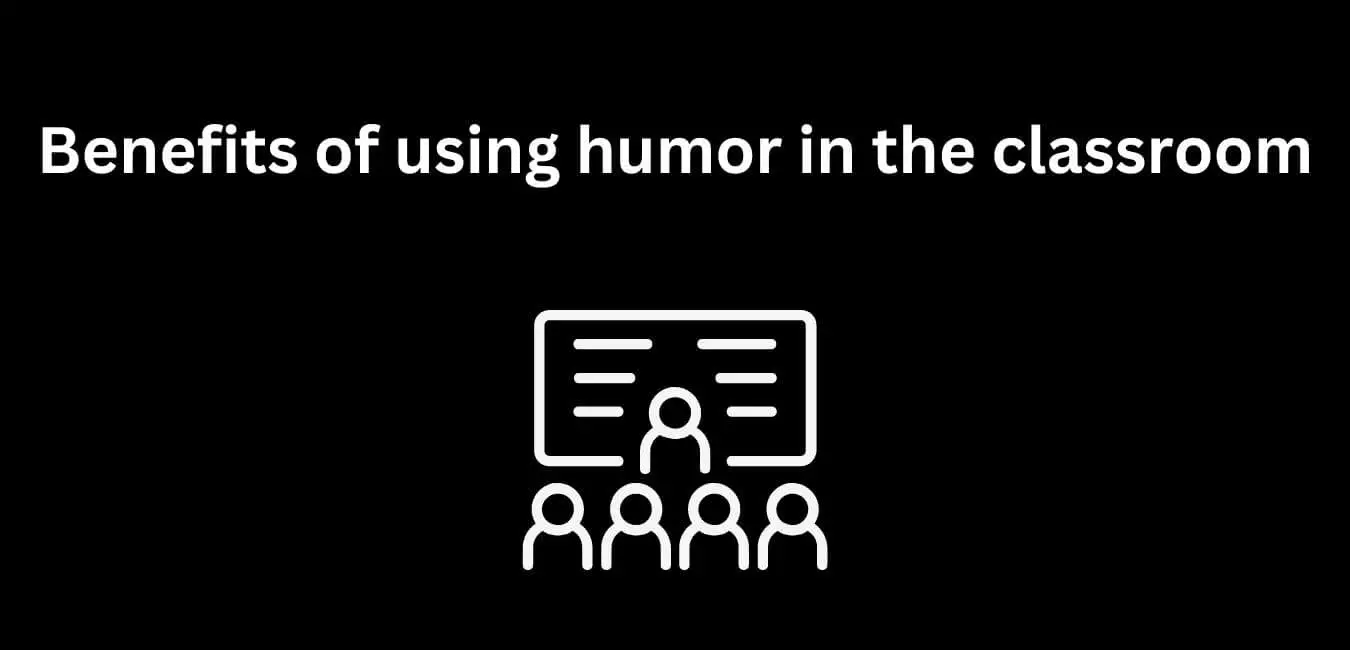Reflective teaching practices have numerous benefits, not only for the students but also for the educators. By engaging in self-reflection and self-assessment, teachers can deepen their understanding of their teaching practices and adapt them to better meet the needs of their students.
In this blog, we will discuss 19 benefits of using reflective teaching practices in teaching in the classroom. From enhancing student engagement to improving teacher effectiveness, reflective teaching practices can truly transform the classroom experience for both the teacher and the students.
So let’s dive into it!
What is Reflective Teaching?
Reflective teaching is an approach that involves an ongoing process of self-evaluation and improvement in teaching practices. It is a process of an ongoing dialogue between teachers and students that aims to develop critical thinking skills and the ability to reflect on one’s own learning.
Reflective teaching requires teachers to think deeply about their teaching methods, the effectiveness of those methods, and how they can improve their teaching practices.
Seven examples of reflective teaching in the classroom include questioning techniques, peer observation, and feedback, keeping a classroom journal, seeking feedback from students, collaborating with other teachers, using assessments to reflect upon teaching effectiveness, and seeking professional development opportunities.
Through these practices, teachers can reflect on their teaching and make improvements to ensure that student learning is maximized.
Reasons Why You Should Use Reflective Teaching Practices
The following are some of the reasons why using reflective teaching practices is important in the classroom:
1. Reflective teaching enhances teaching methodologies
Reflective teaching is a powerful tool that enhances the teaching methodologies of educators. By reflecting on their teaching practices, teachers can identify and address areas for improvement, discover new teaching strategies, and boost their problem-solving skills.
Furthermore, reflective teaching helps in the promotion of inclusive teaching practices, which results in increased student satisfaction. This approach also enhances the attitudes, beliefs, and assumptions of educators towards their profession.
Using reflective teaching practices encourages self-awareness, and sensitivity toward students, and promotes collaboration among teachers. It offers a range of tools for reflective practice and provides an opportunity to understand teaching reality.
By moving beyond just experiencing a lesson to understanding what happened, teachers can make necessary changes to improve their teaching methodologies. Overall, reflective teaching is an essential aspect of professional growth that supports teachers in becoming reflective practitioners and using multiple methods and techniques to engage learners.
2. Encourages self-awareness and sensitivity toward students
Reflective teaching is all about self-awareness and sensitivity toward students. By engaging in reflective practices, teachers can explore their own beliefs, attitudes, and assumptions, and how they influence their teaching.
This self-reflection leads to greater awareness and understanding of the needs and expectations of their students. Teachers who are more aware of their own actions and how they impact their students are better equipped to foster a supportive learning environment.
They can adapt their teaching style to better align with the needs of different students, and provide more personalized support to help those who may be struggling. By being more sensitive to the needs of their students, teachers can create an inclusive classroom that supports all learners.
Reflective teaching practices offer teachers the tools they need to ensure they are providing quality education that meets the needs of their diverse student population.
3. Can lead to improvements in teaching effectiveness
Reflective teaching is a powerful tool that can lead to improvements in teaching effectiveness. By reflecting on their teaching practices, teachers become more aware of what works and what doesn’t.
They can then unlearn ineffective teaching methods, devise new strategies, and ultimately improve their teaching methodologies. Reflective teaching also enhances problem-solving skills, making teachers more innovative and adaptable to the ever-evolving needs of their students.
Through reflective teaching practices, teachers have access to a range of tools they can use to improve their teaching effectiveness. They learn to assess the results of their work, determine the effectiveness and shortcomings of their methods, and adjust their practices accordingly. Ultimately, reflective teaching practices can lead to a more engaged and positive learning experience for both teachers and students.
4. Supports collaboration among teachers
Collaboration among teachers is an essential aspect of reflective teaching practice.
When teachers work in teams, it not only allows them to build meaningful relationships with their colleagues but also gives them a sense of being a part of something more significant than themselves. By working together, teachers can share their knowledge and expertise, imparting valuable insights that go beyond an individual teacher’s experience. Collaboration also creates a support system for teacher growth, where they can learn from one another and generate positive outcomes in educational practices.
Reflective teaching practices not only improve teacher knowledge and skills but also foster inclusive teaching practices that benefit students. Collaboration among teachers thus creates a win-win situation for both teachers and students in the educational ecosystem.
5. Aids in inclusive teaching practices
Reflective teaching practices aid in creating inclusive teaching practices. Teachers are able to reflect on their teaching methods and understand where they can improve to meet the needs of all students.
With this understanding, they can create a learning environment that is inclusive, diverse, and supportive of all students, regardless of their abilities or disabilities. Reflective teaching practices can help teachers to examine their biases and assumptions, and understand how these might impact the way they teach.
It can also help them to develop strategies and techniques to better support students who may need additional help, such as those with disabilities or learning difficulties. By using reflective teaching practices, teachers can create a more inclusive classroom that allows all students to reach their full potential and enjoy their learning experience.
6. Provides an opportunity to understand teaching reality
Reflective teaching practices provide teachers with a valuable opportunity to gain a deeper understanding of the realities of teaching. By reflecting on their own teaching and examining their assumptions and beliefs, teachers can better understand how their actions impact their students’ learning experiences.
Furthermore, reflective teaching encourages self-awareness and sensitivity toward students, which can lead to more inclusive teaching practices. Through collaboration with other teachers, reflective practitioners can also gain broader insights into effective teaching strategies and adapt their methods accordingly.
Additionally, teacher reflection can improve student satisfaction, as instructors can identify areas for improvement and make changes to enhance the learning experience. Overall, reflective teaching practices offer a range of benefits for both teachers and students.
7. Helps to move beyond just experiencing a lesson to understanding what happened
Reflective teaching practices benefit both teachers and students in numerous ways. Moving beyond just experiencing a lesson is an important part of reflective teaching.
By taking the time to reflect on and analyze what happened during a lesson, teachers gain a deeper understanding of their own teaching methods and how they can improve. This self-reflection process helps teachers to recognize their own strengths and weaknesses, enhance their attitudes, beliefs, and assumptions towards teaching, and ultimately lead to improvements in teaching effectiveness.
Additionally, by reflecting on their own experiences, teachers become more self-aware and sensitive toward student needs, leading to increased student satisfaction. Reflective teaching also provides an opportunity for teachers to collaborate with one another and develop inclusive teaching practices. With a range of tools available for reflective practice, such as journals, peer feedback, and coaching sessions, embracing reflective teaching practices can enhance the overall teaching experience for both teachers and students.
8. Enhances teacher attitudes, beliefs, and assumptions
Reflective teaching practices can enhance a teacher’s attitudes, beliefs, and assumptions toward teaching, leading to a more positive and effective learning environment.
When teachers engage in self-reflection, they can evaluate and challenge their personal biases and beliefs, leading to a more inclusive and diverse classroom. It can also help teachers better understand their teaching methodologies and the effectiveness of their teaching strategies.
Additionally, reflective practice can lead to increased satisfaction and motivation in both teachers and students. Through collaboration with other educators, teachers can gain new perspectives and insights, further enhancing their teaching practices. By utilizing reflective teaching practices, teachers can continuously improve and adapt their teaching methods, ultimately benefiting their students’ learning experiences.
9. Increases student satisfaction
When a teacher uses reflective teaching practices, it can positively impact student satisfaction. By being self-aware and sensitive towards their students, teachers can tailor their teaching methods to better engage and support them.
This not only enhances teaching effectiveness but also creates a more inclusive learning environment. Collaborating with fellow teachers and reflecting on their teaching experiences can provide a deeper understanding of the challenges and realities of teaching.
This reflective process can help teachers improve their attitudes, beliefs, and assumptions towards teaching, ultimately benefitting their students. Using a range of reflective tools further supports this growth.
All of these factors work together to create a more effective and engaging learning experience for students, leading to greater satisfaction with their education.
10. Offers a range of tools for reflective practice.
Additionally, reflective teaching practices offer a range of tools that can support teachers in their self-evaluation and assessment of their teaching methods. This range of tools can include using personal histories, dialogue journals, and small and large group discussions. Reflective teachers can also use writing to document their classroom experiences, which allows them to recall and recreate what they have learned.
These tools enable teachers to obtain reliable data for reflection and analysis and help in developing an accurate understanding of their current teaching practices. As a result, reflective teaching practices encourage professional development and enable teachers to respond appropriately to the needs of their students.
11. Enhance Collaboration between Students and Teachers
Reflective teaching practices are essential for creating an effective learning environment that encourages collaboration between students and teachers. By taking the time to reflect on the teaching strategies used in the classroom, teachers can identify areas of improvement and implement new methods to foster collaboration.
Reflective practices also enable teachers to observe their own teaching style and determine which approaches work best for their students. For example, teachers can use reflective teaching strategies to evaluate how well their students are understanding the material and adjust their lessons accordingly.
Additionally, reflective teaching practices help to build trust and respect between students and teachers by emphasizing the importance of open communication and collaboration. Through reflective practice, teachers can create a safe space for students to share their ideas and collaborate with each other. By using reflective teaching practices, teachers can create an atmosphere of mutual respect and collaboration that enhances learning opportunities for all involved.
12. Develop Critical Thinking Skills in the classroom
Reflection is an important part of teaching; it gives teachers the opportunity to evaluate their teaching practices and make necessary adjustments to ensure students are actively engaged in the learning process. Reflective teaching not only helps improve classroom instruction but also develops critical thinking skills among students.
By reflecting on their own teaching practices and making adjustments, teachers can create an environment conducive to the development of critical thinking skills. Through reflective teaching, teachers can foster a classroom culture where students can question, analyze and evaluate ideas and information.
This encourages students to think critically and become more independent learners. For example, teachers can provide opportunities for students to apply what they have learned to real-world scenarios and ask open-ended questions that require students to think critically and come up with their own conclusions.
Additionally, teachers can assign projects or activities that require students to research topics or solve problems independently and then present their findings to the class. Reflective teaching practices are an effective way for teachers to develop critical thinking skills in the classroom; by providing meaningful opportunities for students to question, analyze, and evaluate information and ideas, teachers can create an environment where students can develop the ability to think critically.
13. Develop Empathy and Social Skills in the classroom
Reflective teaching practices are essential for helping students develop empathy and social skills in the classroom. By consciously taking time to reflect on their teaching methods and student responses, teachers can better understand their students and create a supportive environment where students feel comfortable expressing themselves.
Reflective teaching practices involve reflecting on the objectives of the lesson, how instruction was conducted, and how the instruction was received by the students. This can include reflecting on what went well, what could be improved, and how the teacher can better meet the needs of their students.
Furthermore, it can involve identifying which aspects of instruction were successful and which weren’t, as well as analyzing student responses to instruction and determining if any changes need to be made. The goal of reflective practices is to create an environment in which students feel valued and empowered to express their ideas and opinions while developing empathy and social skills. By doing so, teachers can ensure that their students learn not only academic content but also important life skills that they will carry with them long after they leave the classroom.
14. Improve Problem-Solving Skills
Reflective teaching practices can have a tremendous impact on problem-solving skills in the classroom. By encouraging students to think more deeply and critically, teachers can help them develop their problem-solving abilities.
Reflection encourages students to evaluate their own work and consider how their decisions and actions affect the outcome. This can help them become more creative and independent problem-solvers.
Additionally, reflective teaching approaches provide opportunities for students to reflect on their accomplishments and areas for improvement, which can lead to increased motivation and engagement in the learning process.
Furthermore, by discussing and reflecting on problems together, students are able to gain a better understanding of the problem at hand and come up with more innovative solutions. Ultimately, reflective teaching practices can help students become more successful problem-solvers, enabling them to better manage complex challenges in the future.
15. Increase Motivation and Persistence
Reflective teaching practices can make a huge difference in the classroom when it comes to student motivation and persistence.
When teachers incorporate reflective teaching practices into their lesson plans, they create an environment where students can learn and grow in a supportive setting. Reflective teaching practices allow teachers to take the time to understand their students and identify areas of improvement, as well as encourage students to think critically about what they are learning. By providing students with the opportunity to think critically and reflect on their learning, teachers can help boost motivation and persistence in the classroom.
Additionally, reflective teaching practices encourage students to take ownership of their own learning and set goals for their own progress. Through this process, students become more invested in their own development and are more likely to persist in their learning.
Furthermore, reflective teaching practices help foster a sense of community among students and create an atmosphere of collaboration.
Finally, reflective teaching practices provide teachers with the opportunity to assess their own effectiveness as educators and identify areas for improvement in order to ensure that each student is getting the best possible education. Reflective teaching practices are essential for creating an environment that motivates and encourages students to persist in their learning.
16. Increase Confidence in Learning New Things
Reflective teaching practices are essential to creating an environment of learning and growth in the classroom. Through reflective teaching, educators can create a space that encourages students to feel comfortable exploring new concepts and challenging themselves academically.
This type of teaching involves actively considering one’s own beliefs and values, critically reflecting on the choices made during instruction, and responding to feedback from students. By being aware of their own biases, teachers can better understand how classroom decisions impact student learning.
Additionally, reflective teaching can help cultivate a sense of confidence in students by allowing them to take ownership of their own learning process. Through this process, students become more self-reliant and self-aware, boosting their confidence when learning new things.
Reflection also helps teachers understand the environment of the classroom better, allowing them to make adjustments that maximize student success. By implementing reflective teaching practices, educators can empower their students to take risks and become confident problem-solvers.
17. Develop a Sense of Belonging to a Community of Learners
As an educator, one of the most important goals is to create an environment where students feel a sense of community, belonging, and security. Reflective teaching practices have been proven to be an effective way to help students develop this sense of community amongst their peers. By reflecting on their own learning experiences, they are able to build relationships with their classmates and develop a sense of shared identity.
This is done through activities such as group work, discussion, and collaborative projects. Through these activities, students are able to develop a greater understanding of each other’s perspectives and learn to appreciate each other’s strengths and weaknesses.
Additionally, reflective teaching practices allow for open dialogue and communication among students, which helps foster a sense of trust in the classroom. By creating a safe and inclusive environment for learning, teachers can help students connect with each other and develop a strong sense of belonging to the classroom community. Reflective teaching practices are essential for providing students with the tools they need to become successful learners in the classroom and beyond.
18. Enhance Learning Environment Quality
Reflective teaching practices are a crucial tool for creating a successful learning environment in the classroom. It allows teachers to evaluate their own performance and adjust their teaching strategies accordingly. This can be done through self-reflection and analyzing student feedback.
Reflective teaching practices can increase student engagement and help teachers stay organized. By understanding the needs of their students, they are better able to create lesson plans that are tailored to their students’ needs.
Furthermore, reflective teaching practices also provide teachers with the opportunity to identify any issues that may be present within the classroom and take the necessary steps to resolve them. This approach can help create a safe and inviting learning environment in the classroom, which is essential for student success.
Additionally, reflective teaching practices can help teachers understand how their own behavior affects student learning, allowing them to make changes if needed. With this approach, teachers can ensure that each student’s learning experience is as positive as possible. Ultimately, reflective teaching practices can have a profound impact on the quality of learning environments in the classroom, helping to create a more positive and successful experience for both teachers and students.
19. Decrease Absenteeism and Tardiness
Reflective teaching practices are essential for ensuring students’ success in the classroom. By introducing reflective teaching strategies, teachers can help decrease absenteeism and tardiness in their classrooms.
Reflection helps teachers identify areas of improvement in their instruction and increases their effectiveness in engaging with students to create a positive learning environment. Reflection also allows teachers to examine their own teaching practices and adjust them when necessary to ensure students are actively engaged in the classroom.
Additionally, reflective teaching practices can help build a stronger relationship between teacher and student, which can lead to students feeling more connected to their learning and more likely to attend class. For example, reflective teaching strategies such as allowing for student choice or discussing classroom rules together can help students feel like their voice is heard and accepted, which can help them feel more engaged and connected to the learning process. Implementing reflective teaching practices is an effective way for teachers to increase student engagement and reduce absenteeism and tardiness in the classroom.
Conclusion
Using reflective teaching practices can have many benefits for both students and teachers. By taking time to reflect on our teaching practices, we can improve our students’ outcomes and increase our own effectiveness.
















